Can dogs see color?
Many people seem to believe that dogs are color-blind and live their lives purely through a thin veil of grey. Is this actually true, though, are dogs color-blind? And if dogs can see color, which colors do they see?

There is a long-established myth which says that dogs can only see in black, white, or shades of grey. While recent studies have confirmed that these facts are not really all that accurate, there are a few things that we need to keep an eye on. Do dogs see colors like we do, or do they see the world through a different series of tones that our eyes struggle to comprehend?
Can dogs see colors?
It is believed that a dog's color spectrum includes ranges between yellow and blue, meaning that they can indeed see color. Of course, this means that they don't see every single color in existence, but at least they can enjoy a good Van Gogh painting! What else could you want?
More details are emerging when it comes the anatomy of a dog's eyes. It appears that humans perceive a broader technicolor spectrum, while dogs can see a hazy version of most shades. These shades are, as we described them, sometimes a bit hazy and hard to see.
Although a dog's world is not as colorful as their owner's, it is made up for by the fact that our canine companions have a remarkable sense of smell and hearing like a hawk.

What colors can a dog see?
Researchers believe that evolution and basic instincts have led to differences in the development of a dog's eyesight. Dogs in the wild needed their senses as hunters, mostly preying on their food at night. As a result, canines' eyes became more apt to see darker colors and to track movement.
Many now believe that dogs still cannot see red at all, but can see yellow and blue extremely well. They may also perceive greens as yellow – making it challenging for them to chase green and yellow tennis balls when thrown on a grassy field.
Another exciting discovery is that dogs can distinguish between different shades of blue better than most humans even can. They may even be able to recognize small nuances in light blue shades, and differentiate between dark blue and purple.
These are the generally accepted colors and shades that dogs can see:
- Blue
- Yellow
- White
- Black
- Grey
- Combinations of the above
As a result of your dog's crazy eyesight, there are some things that you need to keep in mind. For example, if you want to give your four-legged friend a treat, science now shows that it may be better to buy something that's blue.
What do colors look like for dogs?

Comparisons to red-green color blindness in humans have often been used to help people better imagine what a dog can see. This is the most common combination in people who suffer from color deficiency, with some struggling to see certain colors or differentiate between them.
A dog has so-called dichromatic vision, meaning that it only has two receptor cells, or cones, in the retina of its eye (in comparison, humans have three). Because of this, canines can only perceive two different spectral ranges – yellow and blue – while humans have three. Together, these sensory receptors on the eye's retina divide the light, translate them into color, and then transmit that information into the brain.
While dogs can't see bright colors as well as humans can, and are thought to be short-sighted, a light-reflecting layer that sits on top of their eye allows them to see far better in the dark than we can. This is because their eyes are capable of picking up and absorbing far more light than ours do when in dark places.
Your dog does see color, yes, but in a vastly different way to how we see color. In the dark, though, they have the superior sight - so next time you're walking at night, be sure to bring your canine companion with you!
Cover photo: Collage: 123RF/Seregraff/Jakub Gojda



